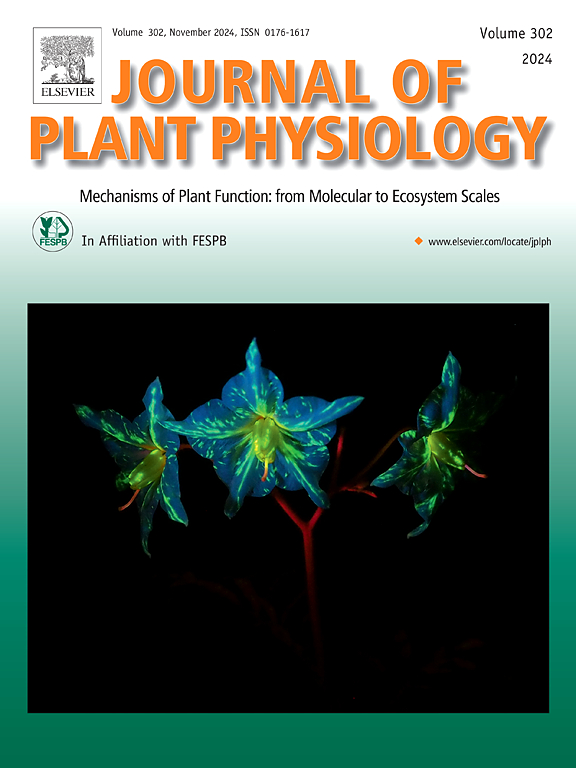拟南芥中水杨酸积累与低花青素产量相关
IF 4.1
3区 生物学
Q1 PLANT SCIENCES
引用次数: 0
摘要
花青素,即类黄酮色素,是植物必需的光保护剂,在增强植物抗环境胁迫能力中起着关键作用。当模式触发免疫(PTI)在拟南芥中被激活时,花青素的产生被抑制。PTI的一个重要成分是植物激素水杨酸(SA)。有趣的是,外源SA处理已被证明可以诱导葡萄、苹果、玉米根、玫瑰愈伤组织或拟南芥幼苗的花青素含量。在这项研究中,我们使用了几个SA含量被调节的拟南芥突变体来解读内源SA在拟南芥花青素生产中的作用。我们在花青素诱导条件下处理WT和突变体,用光谱法测定花青素含量。我们发现高内源性SA积累与低花青素产量相关。用外源SA处理拟南芥幼苗证实了这一点。此外,在5gt突变体中,由于抑制配体依赖的液泡输入,花青素囊泡内含物(AVIs)的产生增加,我们发现高内源性SA也与较低的AVI丰度相关。本研究使用的拟南芥WT和突变体的比较分析表明,在花青素诱导条件下(AICs), SA积累可能对花青素含量有抑制作用。我们认为,在AICs下,独立于NPR1的SA下游信号是降低花青素积累的原因。本文章由计算机程序翻译,如有差异,请以英文原文为准。

Salicylic acid accumulation correlates with low anthocyanin production in Arabidopsis
Anthocyanins, flavonoid pigments, are essential photoprotective agents and play a pivotal role in enhancing plant resilience to environmental stressors. It has been shown that anthocyanin production is inhibited when pattern-triggered immunity (PTI) is activated in Arabidopsis thaliana. An important component of PTI is the phytohormone salicylic acid (SA). Interestingly, exogenous treatment with SA has been shown to induce anthocyanin content in grape, apple, maize roots, rose callus, or Arabidopsis seedlings. In this study, we used several A. thaliana mutants with modulated SA content to decipher the role of endogenous SA in anthocyanin production in A. thaliana. We treated WT and mutants with anthocyanin-inducible conditions and measured anthocyanin content using spectroscopy. We showed that high endogenous SA accumulation correlates with low anthocyanin production. This was confirmed by the treatment of the A. thaliana seedlings with exogenous SA. Additionally, using microscopy in the 5gt mutant, which exhibits enhanced production of anthocyanin vesicular inclusions (AVIs) due to the inhibition of ligandin-dependent vacuolar import, we showed that high endogenous SA also correlates with lower AVI abundance. Comparative analysis of Arabidopsis WT and mutants used in this study indicates a possible inhibitory effect of SA accumulation on anthocyanin content under anthocyanin-inducible conditions (AICs). We suggest that under AICs, SA downstream signaling independent of NPR1 is responsible for lower anthocyanin accumulation.
求助全文
通过发布文献求助,成功后即可免费获取论文全文。
去求助
来源期刊

Journal of plant physiology
生物-植物科学
CiteScore
7.20
自引率
4.70%
发文量
196
审稿时长
32 days
期刊介绍:
The Journal of Plant Physiology is a broad-spectrum journal that welcomes high-quality submissions in all major areas of plant physiology, including plant biochemistry, functional biotechnology, computational and synthetic plant biology, growth and development, photosynthesis and respiration, transport and translocation, plant-microbe interactions, biotic and abiotic stress. Studies are welcome at all levels of integration ranging from molecules and cells to organisms and their environments and are expected to use state-of-the-art methodologies. Pure gene expression studies are not within the focus of our journal. To be considered for publication, papers must significantly contribute to the mechanistic understanding of physiological processes, and not be merely descriptive, or confirmatory of previous results. We encourage the submission of papers that explore the physiology of non-model as well as accepted model species and those that bridge basic and applied research. For instance, studies on agricultural plants that show new physiological mechanisms to improve agricultural efficiency are welcome. Studies performed under uncontrolled situations (e.g. field conditions) not providing mechanistic insight will not be considered for publication.
The Journal of Plant Physiology publishes several types of articles: Original Research Articles, Reviews, Perspectives Articles, and Short Communications. Reviews and Perspectives will be solicited by the Editors; unsolicited reviews are also welcome but only from authors with a strong track record in the field of the review. Original research papers comprise the majority of published contributions.
 求助内容:
求助内容: 应助结果提醒方式:
应助结果提醒方式:


